| |||||||||||||||||||||||
300 members of the Electoral College 151 votes needed to win | |||||||||||||||||||||||
|---|---|---|---|---|---|---|---|---|---|---|---|---|---|---|---|---|---|---|---|---|---|---|---|
| |||||||||||||||||||||||
| |||||||||||||||||||||||
The Argentine presidential election of 1898 was held on 10 April to choose the president of Argentina. Julio Argentino Roca was elected president for a second period.
| |||||||||||||||||||||||
300 members of the Electoral College 151 votes needed to win | |||||||||||||||||||||||
|---|---|---|---|---|---|---|---|---|---|---|---|---|---|---|---|---|---|---|---|---|---|---|---|
| |||||||||||||||||||||||
| |||||||||||||||||||||||
The Argentine presidential election of 1898 was held on 10 April to choose the president of Argentina. Julio Argentino Roca was elected president for a second period.
Having obtained the aging Luis Sáenz Peña's resignation in favor of Vice President José Evaristo Uriburu (who was good stead with both Roca and Mitre), Roca once again carried the PAN standard in 1898. The UCR, which had lost its founder, Leandro Alem, to suicide in 1896, was divided between those who backed Senator Bernardo de Irigoyen's drive to form coalitions with more conservative parties, and those who supported the party's new leader, Hipólito Yrigoyen (who boycotted this and future "election songs" – establishing what later became known as the UCR's "break before bending" policy). [1] Public debate was heated on the eve of the January 30 elections to a constitutional assembly entrusted to increase the number of congressmen and cabinet members, as well before the April 10, 1898, general election. The electoral college yielded no surprises, though, and Roca was returned to the presidency. [2]
| Argentine Republic | |
|---|---|
| Population | 4,462,000 |
| Voters | 89,200 |
| Turnout | 2% |
| Presidential Candidates | Party | Electoral Votes |
|---|---|---|
| Julio Argentino Roca | National Autonomist Party | 218 |
| Bartolomé Mitre | National Civic Union | 38 |
| Total voters | 256 | |
| Did not vote | 44 | |
| Total | 300 | |
| Vice Presidential Candidates | Party | Electoral Votes |
|---|---|---|
| Norberto Quirno Costa | National Autonomist Party | 217 |
| Juan Eusebio Torrent | National Civic Union | 23 |
| Valentín Virasoro | Liberal Party of Corrientes | 7 |
| Julio Argentino Roca | National Autonomist Party | 6 |
| Lino D. Churruarín | Radical Civic Union | 1 |
| Emilio E. Gouchón | Radical Civic Union | 1 |
| Bartolomé Mitre | National Civic Union | 1 |
| Total voters | 256 | |
| Did not vote | 44 | |
| Total | 300 | |
| Province | President | Vice President | ||||||||
|---|---|---|---|---|---|---|---|---|---|---|
| Roca | Mitre | Quirno Costa | Torrent | Virasoro | Roca | Churruarín | Gouchón | Mitre | ||
| Buenos Aires City | 22 | 13 | 22 | 10 | 1 | 1 | 1 | |||
| Buenos Aires | 23 | 18 | 23 | 13 | 5 [lower-alpha 1] | |||||
| Catamarca | 10 | 10 | ||||||||
| Córdoba | 24 | 24 | ||||||||
| Corrientes | 7 | 7 | 7 | 7 | ||||||
| Entre Ríos | 20 | 19 | 1 | |||||||
| Jujuy | 8 | 8 | ||||||||
| La Rioja | 8 | 8 | ||||||||
| Mendoza | 11 | 11 | ||||||||
| Salta | 9 | 9 | ||||||||
| San Juan | 8 | 8 | ||||||||
| San Luis | 9 | 9 | ||||||||
| Santa Fe | 28 | 28 | ||||||||
| Santiago del Estero | 14 | 14 | ||||||||
| Tucumán | 17 | 17 | ||||||||
| Total | 218 | 38 | 217 | 23 | 7 | 6 | 1 | 1 | 1 | |

Juan Hipólito del Sagrado Corazón de Jesús Yrigoyen was an Argentine politician of the Radical Civic Union and two-time President of Argentina, who served his first term from 1916 to 1922 and his second term from 1928 to 1930. He was the first president elected democratically by means of the secret and mandatory male suffrage established by the Sáenz Peña Law of 1912. His activism was the prime impetus behind the passage of that law in Argentina.
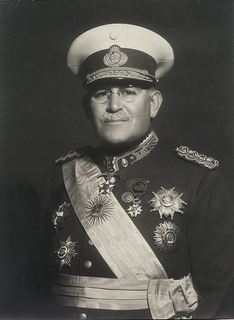
Agustín Pedro Justo Rolón was President of Argentina from February 20, 1932, to February 20, 1938. He was a military officer, diplomat, and politician, and was president during the Infamous Decade. Justo took part in the coup of 1930, becoming president two years later thanks to widespread electoral fraud. His presidency was part of the period known as the Infamous Decade, which lasted from 1930 until 1943. He established the country's central bank and introduced a nationwide income tax.
At the national level, Argentina elects a head of state and a legislature. The franchise extends to all citizens aged 16 and over, and voting is mandatory for all those who are between 18 and 70 years of age.
The Union of the Democratic Centre is a centre-right conservative-liberal and economically liberal political party in Argentina. It was founded in 1982 by Álvaro Alsogaray who unsuccessfully run in the 1983 and 1989 presidential elections, and represented the conservative elite, technocrats, and classical liberals.

Argentina held national presidential and legislative elections on Sunday, 28 October 2007, and elections for provincial governors took place on staggered dates throughout the year. For the national elections, each of the 23 provinces and the Autonomous City of Buenos Aires are considered electoral districts. Voter turnout was 76.2%. Buenos Aires Province Senator and First Lady Cristina Fernández de Kirchner of the Front for Victory won the election by 45.28% of votes against Elisa Carrió of Civic Coalition ARI, making her the second female president of Argentina and the first female president to be directly elected. She broke the 40 percent barrier and won in the first round. Elisa Carrió won in the city of Buenos Aires and came second with more than 20 percent of the votes. Third was Roberto Lavagna, who won in Córdoba.

The Argentine general election of 1931 was held on 8 November.

The Argentine general election of 1928 was held on 1 April, with a turnout of 80.9%.
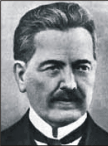
General elections were held in Argentina on 2 April 1916. Voters elected the President, legislators, and local officials. The first secret-ballot presidential elections in the nation's history, they were mandatory and had a turnout of 62.8%. The turnout for the Chamber of Deputies election was 65.9%.
Argentina held nine presidential elections between 1862 and 1910, every six years.

Argentine legislative elections of 1912 were held on 7 April 1912 for the Argentine Chamber of Deputies. The first free, democratic elections in the nation's history, the contest had a turnout of 73%.
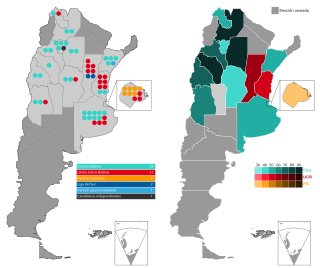
The Argentine legislative elections of 1914 were held on 22 March. Voters chose their legislators, and with a turnout of 58%.

The Argentine legislative elections of 1918 were held on 3 March. Voters chose their legislators and numerous governors, and with a turnout of 56.4%.
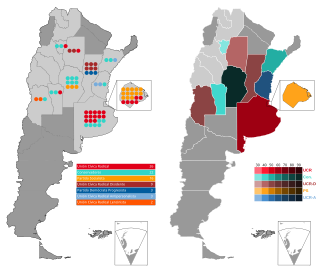
The Argentine legislative elections of 1924 were held on 2 March. Voters chose their legislators and numerous governors, and with a turnout of 44.2%.

Argentina held national presidential and legislative elections on Sunday, 23 October 2011. Incumbent president Cristina Fernández de Kirchner of the Front for Victory won via landslide, with 54.11% of votes against Hermes Binner of Broad Progressive Front, she also secured a second term in office after the Front for Victory won just over half of the seats in the National Congress.
The Concordancia was a political alliance in Argentina. Three presidents belonging to it, Agustín P. Justo, Roberto Ortiz, and Ramón Castillo were in power from 1931 to 1943, a period known in Argentina as the "Infamous Decade."

The Argentine presidential election of 1880 was held on 11 April to choose the president of Argentina. Julio Argentino Roca was elected president.
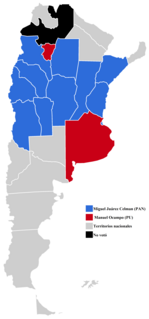
The Argentine presidential election of 1886 was held on 11 April to choose the president of Argentina. Miguel Juárez Celman was elected president.
The Argentine presidential election of 1892 was held on 10 April to choose the president of Argentina. Luis Sáenz Peña was elected president.
The Argentine presidential election of 1904 was held on 10 April to choose the president of Argentina. Manuel Quintana was elected president.
The Argentine presidential election of 1910 was held on 13 March to choose the president of Argentina and 63 of 120 seats in the Chamber of Deputies. Roque Sáenz Peña was elected president.